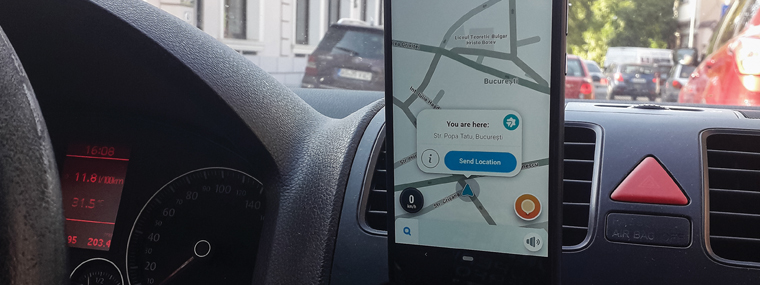
Making the Most of GPS Technology
By Diane M. Calabrese / Published April 2020

Things that leave and do not come back…now that’s a mixed category.
Good riddance to flies, mold, drain clogs, and such. But when a pressure washer vanishes, it’s at best exasperating and likely infuriating.
Could GPS technology be the answer? Perhaps. Construction companies make extensive use of GPS. (See the sidebar, GPS.gov, for the basics of the global positioning system.) By equipping their equipment with tracking devices, the firms can better locate and recover machines that disappear.
Tracking services are numerous and easy to find via a web search. They range from focused enterprises to sub-entities of large internet providers.
Before appraising what services offer, it’s valuable to gain appreciation of the benefits and the limitations of GPS tracking. Roy Pennington, owner of Hi Pressure Cleaning Systems Inc. in Houma, LA, is an enthusiastic user of the technology.
“Absolutely priceless value” is the way Pennington describes GPS tracking technology. “Every time I see a CETA ‘BOLO’ (be on the lookout) for stolen rental units, I appreciate the value of having my high-end units equipped with GPS capabilities.”
Rental equipment from Pennington’s company heads in many directions. From an avian flu decontamination project in Iowa to hazmat and decontamination projects in Texas and bulk oil tank storage battery (hurricane damage) cleanup in Nassau, Bahamas, the machines are on the move. “It is reassuring to see where equipment is in real-time perspective,” he explains.
Capabilities of GPS enable companies to do a lot more than just know where equipment is. They can also determine how it’s being used. “We have more and more decontamination customers who are requesting that we leave hot water skid, water tank trailer packages on their yards for 24-hours grab-and-go capability,” says Pennington. “They assure us that when they do use the equipment, they will call in a purchase order and give us start and stop times on the rental.”
After having tried what the customers suggested, Pennington discovered it did not work well. Finding equipment gone from one yard when driving by, he was told that it was “the new guy” who forgot to call in the purchase order. “Since equipping our units with GPS units with a battery sentinel monitor, we have brought a new level of honesty to our relationships.”
Pennington explains the monitoring unit will run on an internal battery for 21 days and send out a low battery alert. It signals the owner of the equipment if it moves more than five feet from the location where it was logged in.
“An even more beneficial perk is the fact that it has the capability to monitor when the engine is actually running,” says Pennington of the monitor. It puts a quick end to conversations that begin with the renter saying no work was done on the weekend.
The cost of the system Pennington uses is typical of the many systems advertised. It is not prohibitive, he explains.
“Cost is such an insignificant factor when it comes to GPS monitoring,” says Pennington. “We purchase our hardware for a one-time fee of about $200 and then a $12 monthly monitoring fee per unit. When you get to bill just one rental that you would not have otherwise known about, you are ahead in the profit picture.”
Moreover, that’s all coupled with knowing where expensive trailer packages are 24/7, explains Pennington. Balance is essential when planning how and when to use tracking, though.
In the past, Pennington’s company had tracking on all vehicles. But the particular system became “more tedious than beneficial” and was not renewed. For instance, it indicated a driver made a longer run than necessary. Indeed, the driver had in order to circumvent a bridge that was not in service.
Equipping company phones of new sales personnel with tracking devices has enabled Pennington to counsel those who did not understand that they were to work a set number of hours and not co-mingle personal travel and other activities with sales. The employees knew from the onset about the tracking, and they presented creative rationales to explain their deviant paths.
There are as many ways to use tracking as there are needs. “After a recent not-at-fault auto accident that could have easily evolved into a he said/she said argument, all our vehicles are equipped with forward-facing video cameras that record when the vehicle is in use,” explains Pennington. The one-time cost is about $50 per unit.
Traps and Trappers
Better trap, smarter mouse…It’s a tired but all-too-true aphorism. Think hackers and the time and money invested in thwarting them every second of every day.
With GPS being used in real time to track the whereabouts of everything from concrete forms and bicycles to cemetery plots, those who would find a way to confound tracking devices pursue nefarious ends without interruption. The December 2019 issue of Scientific American includes an article by Paul Tullis titled “GPS Down”—and sadly, it’s a reminder of what catastrophic events can happen when aircraft pilots lose GPS guidance.
If a GPS signal is jammed or otherwise tampered with, a distributor may lose some information about rental equipment, but the loss will be tolerable. Not so for the electrical grid or myriad critical systems that depend upon GPS.
We trust that the U.S. Department of Homeland Security is working diligently to eliminate vulnerabilities in GPS. On a local scale, users of monitoring devices can add a barrier to hackers by not tying their computer systems and monitoring systems together without proper security.
Monitoring is not a stand-alone way to prevent theft or misuse of equipment and time. It must be part of a multi-faceted approach. The insurance and risk sectors refer to the comprehensive task as loss control.
The control begins with ascertaining all employees understand that loss prevention is part of company policy. Similarly, they should understand that part of their workplace responsibility includes participating in the prevention of loss.
Equipment does not just walk away at distributorships. It can also go missing from contractor sites. Contractors must secure equipment that is not in use. (How many times has each of us passed a contractor’s vehicle only to note the side doors open and the contractor not in sight?)
Safety is a major reason to keep everything in its proper place and to have storage space for all tools. Yet, bringing order to the movement of equipment and ancillaries also makes it easier to make sure nothing has gone missing. (Distraction, which includes disorder in storage spaces, is a situation thieves exploit when committing crimes.)
Use the most sophisticated methods possible to secure equipment and tools. Consider using fingerprint access to open locks, but some items might be better secured at job staging areas with heavy chains and hardened steel locks. (Yes, fingerprint readers can be hacked.)
Visit worksites and sites where rental equipment is in use to learn how equipment is being handled. (Misuse of equipment can lead to losses as significant as theft.)
Distributors and large contractors with staging areas know the importance of lighting, fencing, and security systems. Security personnel can help, although they must be well screened and well trained, so as not to add to liabilities.
GPS technology is not a stand-alone solution to protecting businesses from loss. It must be part of a bigger strategy, and the entire program must involve employees.
In the case of putting tracking devices on phones, an employer may or may not have to advise employees that the devices are there, depending on state laws.
It’s always better to err on the side of disclosure because laws may change, and legal challenges arise. Usually, a general disclosure such as “security tracking devices are in use at this company” will do, as long as all employees sign off that they have been duly informed.
One forward-looking tracking solution to loss prevention could be adapted by our industry if sufficient industry members participated. It derives from a community-based app produced by SQUIDD Lock in 2015. A motion alert, theft alert, and community alert are all part of the system, which can be located at www.prnewswire.com/news-releases/squidd-lock-introduces-the-worlds-first-anti-theft-smart-lock-with-community-based-app-300951674.html. Imagine an app that connected all owners of pressure washers!
GPS.gov
A government-owned utility, the Global Positioning System (GPS) is freely available to civilian users; it also serves the military. It provides positioning, navigation, and timing services via the interaction of three components: space (satellites 12,500 miles from earth’s surface transmitting one-way signals); control (worldwide monitoring stations that maintain satellites); and user (receives GPS signals to determine position and time).
Entities that require precise time synchronization (e.g., banking, communications, power grids) use GPS, as do industries such as farming, construction, mining, surveying, package delivery, and logistical supply chain. Because of the rigor with which GPS pinpoints time and place, it is vital to the operation of devices designed to track location of equipment.
For details about the arrangement of the 24 satellites (and “extras”) comprising the space component, including a poster for download as well as answers to frequently asked questions, future plans for modernization, and much more, see GPS.gov.





